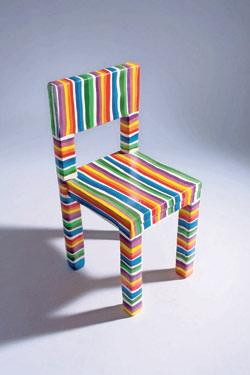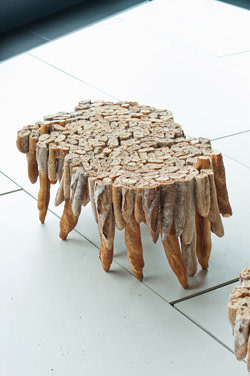Good enough to eat: the furniture crafted from edible materials

Simply sign up to the Life & Arts myFT Digest -- delivered directly to your inbox.
It might sound a bit Roald Dahl, but chairs made of boiled sweets are no longer the stuff of fiction. In fact, edible furniture designs look like they are here to stay – if one can resist eating them.
From a table fashioned out of baguettes to a chair crafted from tofu, food products are a tempting option for designers looking to experiment with unusual materials that are biodegradable and low-impact. Household ingredients such as flour, salt and sugar, staples once confined to the kitchen cupboards, are now being brought into the sitting room – where they appear as one of the main ingredients.
Take, for instance, Dutch designer Pieter Brenner’s Sugarchair. Brenner uses 30 kilos of sugar to create each piece of rainbow-coloured furniture. “I opted to use sugar because it is one of the most versatile, durable and sustainable food products,” he says.
With the help of a sugar specialist, Brenner uses a formable sugar material, adds starch and water, and moulds the chair using the mixture. Once dry, he glazes the chair with coloured icing sugar before finally coating it with a lacquer to ensure it is smooth and not sticky. Brenner says the final product – which sells for €18,500, with only three produced every year – is as sturdy as wood. The chair is not only functional; it also looks good in the home and is 100 per cent edible.
“The interesting thing about sugar as a design material is that it has little impact on the environment in that it’s biodegradable. So, for example, the sugar chair can be eaten or melted when no longer useful or desired,” says Brenner.
An exhibition of furniture made of edible products at last year’s Salone Internazionale del Mobile, Milan’s annual furniture fair, proved that food is more than just a good source of nutrients; it’s also an exciting medium for inventive interior designs.

As part of the exhibition, Singapore-based design studio Lanzavecchia + Wai created a hard candy table. The decorative or superfluous parts of the table – made from one huge hard-boiled sweet – can be nibbled away, revealing a black iron base that doubles as a side table.
But not all food-based furniture is designed to be eaten. Because it needs to be hardened, most furniture made of food products is mixed with other organic material to make it stronger and more durable, meaning it is no longer safely edible.
Daniel Widrig, a German architect and designer based in London, says it isn’t so much an interest in creating edible furniture as the cost-saving benefits that drive the trend for food products in interiors. “My interest in food products didn’t stem from a specific interest in working with food, but rather with the idea of using inexpensive, non-toxic, off-the-shelf household materials that are available in bulk.”
Widrig’s Degenerate chair, which he produced for the FRAC Centre’s permanent design collection in France, was 3D-printed using a special blend of sake (Japanese rice wine), a food additive called maltodextrin and plaster of Paris.
The process originally involved using a patented powder and binder, which is expensive as they only use one manufacturer. “We often need to print large prototypes and were always hindered by the huge production costs,” says Widrig.
So using his open-source sake concoction, Widrig found an alternative to the original material, which works as effectively but for a fraction of the cost. One litre of the original binder sells for £200 while a litre of sake is only £8. With additional research, Widrig says that the organic binding material could provide a low-cost alternative to expensive industrial supplies.

It is not just the cost-saving benefits that are enticing designers. Food products also have interesting structural properties – different from those found in materials like wood, metals and plastics – that designers are keen to experiment with.
Intrigued by the idea of constructing a solid piece of furniture from a soft, edible material, Italian designer Leonardo Talarico decided to test the structural limits of soyabean curd and created the Tofu chair. “I thought to myself, ‘why not take one of the softest foods and make it stronger?’,” he says.
In order to turn each bite-size piece of tofu into a durable building block, Talarico had to dehydrate and subject each chunk to thermal-shock treatment. This hardened the tofu, giving it a wood-like rigidity. Each piece was layered, much like Lego bricks, to create the chair before being treated with natural colour to give it the appearance of cooked tofu. This “masked any remaining scent, making the chair odourless,” says Talarico.
The chair – which costs €9,000 – is completely edible. The challenge for Talarico was retaining the taste and material integrity of tofu while making it solid enough to create furniture from. “What fascinated me was how you could transform and manipulate bean curd. Tofu is cheap and, at the same time, complex. It has distinct aesthetic and structural qualities that make it interesting to work with.”
Bread also has the potential to become a sturdy material when mixed with other organic substances. For instance, Netherlands-based design duo Formafantasma have created a series of vases, bowls and lamps made from baked bread, composed of 70 per cent flour mixed with 20 per cent agricultural waste and 10 per cent natural limestone. The mixture is hardened by baking it at low temperatures and dyed using tints from vegetables, spices and roots.
“When we think of today’s production processes, they are increasingly linked to the food world. Biodegradable or bio-friendly materials are produced by processing corn, wheat and potatoes,” says Andrea Trimarchi, one half of Formafantasma. In this sense, he says, their project pays homage to the production and design possibilities that food offers.
Comments